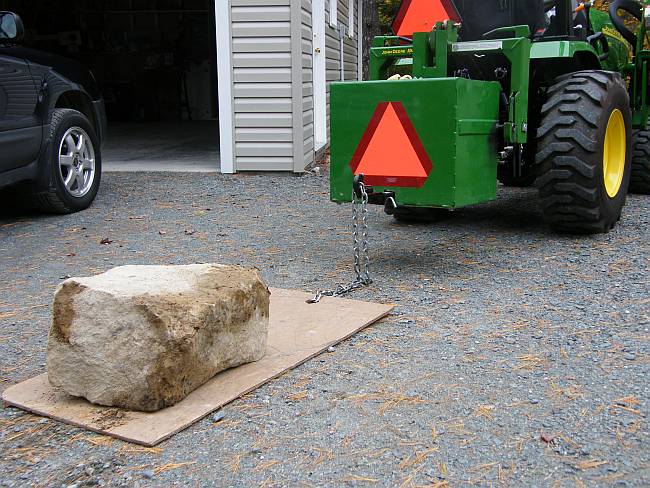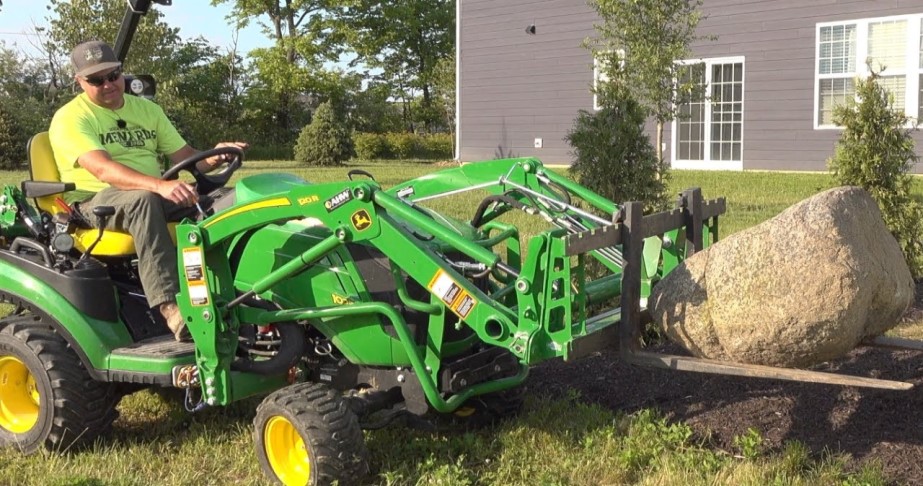Moving large rocks is no easy feat. The physical and logistical difficulties can be overwhelming.
These challenges include the sheer weight of the rocks, maneuvering around obstacles, and ensuring the safety of both the operator and the equipment.
It’s important to understand and plan for these challenges before embarking on any rock-moving project.
With the right knowledge, equipment, and techniques, you can master the art of moving any large rock with a tractor.
Moving Large Rocks with a Tractor: Step-by-Step Guide
Let’s explore the steps involved in the process.
Assess Your Equipment
Ensure that your equipment is suitable for the task at hand. Consider the following factors when evaluating your tractor.
- Horsepower
Determine if your tractor has enough power to handle the weight of the rocks you intend to move. Higher horsepower allows for better performance and maneuverability.
- Lifting Capacity
Check the lifting capacity of your tractor’s hydraulic system. This specification indicates the maximum weight the tractor can lift safely.
Ensure that it’s sufficient for the size and weight of the rocks you plan to move.

- Tire Grip
Assess the condition of your tractor’s tires and their ability to provide adequate traction on the terrain where the rocks are located. In some cases, you may need specialized tires or chains for improved grip.
Related: Best Equipment to Move Large Rocks
Prepare for the Task
Proper preparation is essential to ensure a smooth rock-moving operation. Follow these steps to prepare for the task.
- Survey the Work Area
Take the time to survey the work area and identify the rocks you intend to move. Determine their size, shape, and approximate weight.
This information will help you choose the appropriate technique and equipment for the job.
- Evaluate the Terrain
Assess the terrain where the rocks are located. Look for any potential obstacles, such as trees, fences, or uneven ground that may hinder the movement of the tractor or pose a safety risk.
- Inspect and Maintain Your Equipment
Before starting the task, inspect your tractor and attachments thoroughly. Check for any signs of damage, leaks, or worn-out components.
Ensure that all hydraulic systems are functioning correctly.
Perform routine maintenance tasks, such as changing fluids and lubricating moving parts, to keep the equipment in optimal working condition.
Choose the Right Technique

There are several techniques you can employ to move large rocks with a tractor.
The choice of technique depends on factors such as the size and weight of the rocks, the terrain, and the equipment available.
Let’s explore some common techniques.
Related: 5 Best Ways to Move River Rock by Hand
- Rolling
This involves leveraging the tractor’s power to roll rocks by pushing them with the front-end loader or other attachments.
It’s suitable for moderately sized rocks on flat or slightly sloped surfaces.
- Dragging
Dragging involves attaching a chain or tow strap to the rock and using the tractor’s power to pull it along the desired path.
This technique is effective for moving rocks with irregular shapes or when rolling isn’t feasible due to obstacles or terrain conditions.
- Lifting
When dealing with exceptionally large or heavy rocks, lifting is often the preferred technique.
Attach a loader or forks to the tractor and use hydraulic power to lift the rock off the ground. This technique allows for precise control and relocation of the rock.
- Combination Techniques
In some cases, a combination of techniques may be necessary.
For example, you might roll a rock to a more accessible location and then use lifting to reposition it precisely.
Essential Safety Precautions
Safety should always be a top priority when moving large rocks with a tractor. Follow these essential safety precautions to minimize risks and potential accidents.
- Wear Protective Gear
Before starting any task, ensure you and anyone involved in the operation wear appropriate protective gear, including helmets, gloves, safety glasses, and sturdy footwear.
- Know Your Equipment’s Limitations
Understand the capabilities and limitations of your tractor and attachments.
Don’t exceed the lifting capacity or attempt to move rocks that are too large or heavy for your equipment to handle safely.
- Secure the Work Area
Mark the work area to alert others of the ongoing operation and keep bystanders at a safe distance. Remove any unnecessary personnel or objects from the immediate vicinity.

- Communicate and Establish Clear Signals
Establish clear communication between the tractor operator and any helpers or spotters.
Use hand signals or two-way radios to ensure effective communication during the rock-moving process.
- Be Mindful of the Terrain
Pay close attention to the terrain and any potential hazards, such as steep slopes, loose soil, or unstable ground.
Adjust your approach accordingly and avoid working in adverse weather conditions.
Related: Mexican Landscapers/Yard Workers: What You Must Know
Execute the Task
With your equipment assessed, preparations made, and safety precautions in place, it’s time to execute the rock-moving task. Follow these steps for a successful operation.
- Position the Tractor
Park the tractor in a safe and stable location near the rock you wish to move. Ensure that the tractor is on level ground and engage the parking brake.
- Attach the Necessary Equipment
If using a front-end loader or forks, attach them securely to the tractor’s hydraulic system following the manufacturer’s instructions.
Ensure that all connections are tight and the attachment is properly aligned.
- Evaluate the Rock
Examine the rock you intend to move and determine the best gripping or lifting points. Avoid areas that are weak, fractured, or likely to break off during the movement.
- Approach the Rock
Slowly maneuver the tractor closer to the rock, maintaining a safe distance to avoid collision or damage to the equipment.
Position the attachment in a way that allows for optimal gripping or lifting.
- Grip or Lift the Rock
Engage the hydraulic system to grip or lift the rock using the appropriate attachment.
Follow the recommended technique for the chosen approach (rolling, dragging, or lifting) and apply gradual and controlled force as needed.
- Move the Rock
Once the rock is secured, start moving it according to the chosen technique.
Use the tractor’s power to roll, drag, or lift the rock to its desired location, taking into account any obstacles or terrain conditions.
- Monitor and Adjust
Continuously monitor the movement of the rock and make any necessary adjustments to ensure stability and safe transportation.
If encountering difficulties or unexpected challenges, assess the situation and consider alternative approaches or seek assistance if needed.
- Place the Rock
Once the rock has been transported to the desired location, carefully release the grip or lower it to the ground, depending on the chosen technique.
Ensure the rock is stable and properly positioned.
How to Move Large Rocks with a Tractor (Video)
Related
- Monument Grills Vs Weber Grills Review
- Shadow Box Fence Pros and Cons
- Shadow Box Fence Vs Board on Board Fence (Side by Side Comparison)
- Best Paslode Framing Nailers Review
- Top 5 Freeman Framing Nailers Review
- Best Numax Finish & Framing Nailers Review
- 8 Best Metabo Framing Nailers Review
- Advantages and Disadvantages of Dog Eared Fence
- Clearly Filtered Vs Aquagear Water Filter Pitcher (Comparison)
- Best Pneumatic Nail Guns Review
- 6 Best Royal Gourmet Grills Review
- Best Equipment to Move Large Rocks (Without a Doubt)

